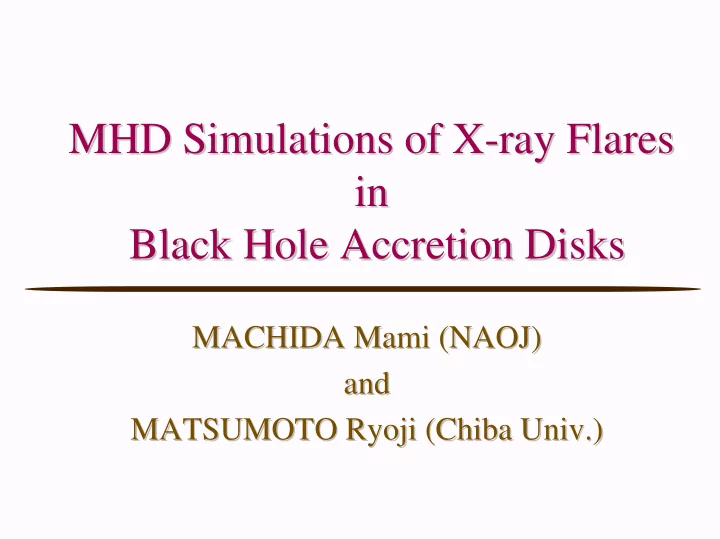

MHD Simulations of X- -ray Flares ray Flares MHD Simulations of X in in Black Hole Accretion Disks Black Hole Accretion Disks MACHIDA Mami Mami (NAOJ) (NAOJ) MACHIDA and d an MATSUMOTO Ryoji Ryoji (Chiba Univ.) (Chiba Univ.) MATSUMOTO
Introduction Introduction
X- -ray Flares in ray Flares in Cyg Cyg X X- -1 1 X Cyg X-1 (hard state) : Violent fluctuation is observed in the X-ray hard state. Negoro et al. 2001 X-ray shot : X-ray intensity increases exponentially. Spectral softening is observed before the peak of the shot. The spectrum hardens within several milliseconds after the peak. ( Negoro et al. 1 9 9 5 ) X-ray counts from Cyg X-1
17 min Oscillation of Sgr A* X-ray light curve (October 3 2002) X-ray light curves of Sgr A* has almost same properties as galactic black hole candidate such as rapid X- ray variability and some peaks. X-ray flux has some peaks, ~ 100s, 219s, 700s, 1150s, 2250s. X-ray emissions are correlated with NIR and Aschenbach et al. (2004) radio.
The Purpose of our Study The Purpose of our Study • The physical mechanism of X-ray flares – Magnetic energy release in radiatively inefficient accretion disks ? ( ⇒ Machida & Matsumoto 2003) • Relation between X-ray flares and disk oscillations
NUMERICAL MODEL NUMERICAL MODEL
Basic Equations Basic Equations ∂ ρ ( ) + ∇ ρ = Equation of continuity v 0 ∂ t Equation of motion ∂ + ⋅∇ = − v 1 1 ( ) ∇ + ∇× × −∇ φ v v P B B ∂ ρ πρ t 4 ∂ B ( ) ( ) = ∇ × −∇× η ∇× Induction equation v B B ∂ t Equation of energy conservation ∂ ρε ( ) + ∇ ρε + ∇ = v P v Q ∂ j t ( ) η − 2 > v v v v η = Anomalous resistivity d c 0 d c < v v 0 d c
Initial Model & Simulation Parameters Initial Model & Simulation Parameters Assumption Gravitational potential φ = - GM/(r-r g ) Constant angular momentum torus Anomalous resistivity Ignored self gravity of disk Unit radius : r g =1 r g : Schwartzschild radius velocity : c ( light speed ) =1 density : ρ 0 =1 Parameter 250*64*192 meshes The radius of pressure maximum r 0 = 50 r g β≡ P gas /P mag = 100 at r=r 0 The ratio of gas pressure to magnetic pressure γ =5/3 Specific heat ratio η 0 = 5 × 10 -4 Anomalous resistivity ρ h0 / ρ 0 =10 -4 The ratio of initial halo density to the maximum equatorial density Critical ion-electron drift velocity v c =0.9
NUMERICAL RESULTS NUMERICAL RESULTS
Formation of an Accretion Disk Formation of an Accretion Disk t=26350 Initial model unit time t 0 =rg/c The equilibrium torus threaded by weak toroidal magnetic fields ( β =100). Magnetic fields are amplified due to the magneto-rotational instability and saturates when plasma β is about 10. The MHD turbulence driven by MRI enhances the angular momentum transport rate and enables mass accretion.
Magnetic Field Lines Magnetic Field Lines Magnetic field lines projected onto the equatorial plane (-60 < x,y < 60) (-10 < x,y < 10) 10 60 60 10 -10 10 -60 60 -60 60 -10 10 Inner region Outer region Magnetic field lines are tightly wound. Magnetic field lines are less turbulent and globally show bisymmetric spiral shape (BSS). ⇒ Turbulent motions are dominant in the disk.
Magnetic Reconnection in the Innermost Region Magnetic Reconnection in the Innermost Region ϖ Volume integrated Joule heating rate (2< <6,0< φ <2 π , 0<z<10) T=30590 The above figure shows the time evolution of the volume integrated Joule heating rate. The arrow T=30610 indicates the time when the largest magnetic 5 reconnection takes place. Right panels show the distribution of current density. The red region show the region where current density is high. The electric current dissipates as magnetic reconnection proceeds. -5 T=30630 -10 10
Longer Time Scale Simulation for Cooler Disk Longer Time Scale Simulation for Cooler Disk Density distribution
Longer Time Scale Simulation for Cooler Disk Longer Time Scale Simulation for Cooler Disk Yellow ρ =0.2 Green ρ =0.1
Distribution of Azimuthally Magnetic Field Distribution of Azimuthally Magnetic Field Averaged toroidal magnetic field Non-averaged toroidal magnetic field Sometimes, emergence of magnetic flux from the disk to its corona. coherent oscillation pattern appears in the inner most region.
Sawtooth- -like Oscillations in Accretion Disks like Oscillations in Accretion Disks Sawtooth Accretion rate Joule heating rate
Power Spectrum of Luminosity Variations Power Spectrum of Luminosity Variations Spatial distribution of the Power Spectrum Power Spectral Density LFQPO Hz HFQPO 1Hz 10Hz 100Hz Low Frequency Oscillation in the Inner Torus Excites High Frequency Disk Oscillations
SUMMARY SUMMARY • We found that sawtooth-like oscillation takes place in the innermost region of radiatively inefficient accretion disks. • The sawtooth oscillation is triggered by the growth of the non-axisymmetric m=1 mode in the inner torus, which amplify magnetic fields. • The accumulated magnetic energy is suddenly released by magnetic reconnection. This may correspond to X-ray shots observed in Cyg X-1 and possibly explain flares observed in Sgr A* • The X-ray flare forces the disk to oscillate with frequency comparable to the epicyclic frequency of the inner torus. • Such oscillations may explain high frequency QPOs observed in black hole candidates.
Recommend
More recommend